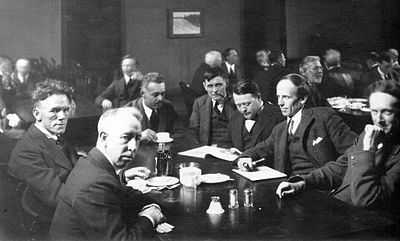Arthur Lismer
| Arthur Lismer | |
|---|---|
 Arthur Lismer, 1930 | |
| Born |
27 June 1885 Sheffield, England |
| Died |
23 March 1969 (aged 83) Montreal, Quebec |
| Nationality | British and Canadian |
| Known for | Painter |
| Awards | Order of Canada |
Arthur Lismer, CC (27 June 1885 – 23 March 1969) was an English-Canadian painter and member of the Group of Seven.
Early life
At age 13 he apprenticed at a photo-engraving company. He was awarded a scholarship, and used this time to take evening classes at the Sheffield School of Arts from 1898 until 1905. In 1905, he moved to Antwerp, Belgium, where he studied art at the Academie Royale.
Lismer immigrated to Canada in 1911, settled in Toronto, Ontario and took a job with Grip Ltd. - a satirical magazine.
President of NSCAD University
From 1916-1919 Lismer served as the President of the Victoria School of Art and Design (now the Nova Scotia College of Art and Design).
Official war artist

In wartime Halifax, Lismer was inspired by the shipping and naval activity of the port, notably the dramatically painted dazzle camouflaged ships. This work came to the attention of Lord who arranged for Lismer to be commissioned as an official war artist.[1] His best-known work from the war years depicted what he observed and learned about in Halifax, Nova Scotia: Mine sweeping, convoying, patrolling and harbor defense.[2] He also did some sketches of the Halifax Explosion.
Group of Seven

The collaboration of four artists at Grip gradually evolved into the "Group of Seven", whose work was intended to contribute to the process of giving Canada a distinctive national voice in painting.[3] The group was known for its depictions of the North American wilderness. Another artist also associated with the group was Tom Thomson, although technically he died before the group formed. He also worked with the cadre at Grip.
Arthur Lismer's style was influenced by his pre-Canadian experience (primarily in Antwerp), where he found the Barbizon and post-impressionist movements a key inspiration.
Collaborating with the group of artists who would, in 1919, become the Group of Seven, Lismer exhibited the characteristic organic style, and spiritual connection with the landscape that would embody that group's work.
During the Centennial of the City of Toronto, in 1934, Lismer was on the Pictures Committee. His work in art education was effective; and this service to the wider community caused Lismer to become influential in ways not achieved by his artist colleagues. For example, he started a children's art program at the Art Gallery of Toronto which became successful in the 1930s.[4]
Several members of the Group of Seven later became members of the Canadian Group of Painters including Lawren Harris, A. J. Casson, Arthur Lismer, A. Y. Jackson, and Franklin Carmichael. The gallery L'Art français exhibited his works.[5]
He was made a member of the Royal Canadian Academy of Arts.[6] In 1967, he was made a Companion of the Order of Canada.
Lismer died on March 23, 1969 in Montreal, Quebec and was buried alongside other members of the Original Seven at the McMichael Gallery Grounds.
Legacy
In Toronto, Lismer Hall, the auditorium at Humberside Collegiate Institute is named in his honour. He painted one of the largest murals in Canada for the school during the 1930s that hangs on the auditorium's walls today.
See also
Notes
- ↑ Brandon, Laura. (2008). Art and War, p. 46., p. 46, at Google Books
- ↑ Gallatin, Albert. (1919). Art and the Great War, p. 142., p. 142, at Google Books
- ↑ Grigor, Angela Nairne. (2002). Arthur Lismer, Visionary Art Educator, p. 54., p. 54, at Google Books
- ↑ Reid, Dennis R. (1988). A Concise History of Canadian Painting, p. 179.
- ↑ "L'Art Français in Montreal", Gallery Profile, in Le Collectionneur, Vol.1, n°2, 1978, "L'Art Français also sold the paintings of more "classical" painters such as (...) Lismer"
- ↑ "Members since 1880". Royal Canadian Academy of Arts. Retrieved 11 September 2013.
References
- Brandon, Laura. (2008). Art and War. New York: I.B. Tauris. 10-ISBN 1845112377/13-ISBN 9781845112370; OCLC 225345535
- Darroch, Lois. (1981). Bright Land: a Warm Look at Arthur Lismer. Toronto: Merritt. 10-ISBN 0920886078/13-ISBN 9780920886076; OCLC 421844431
- Gallatin, Albert Eugene. (1919). Art and the Great War. New York: E.P. Dutton. OCLC 422817
- Grigor, Angela Nairne. (2002). Arthur Lismer, Visionary Art Educator. Montréal : McGill-Queen's University Press, 2002. 10-ISBN 0773522956/13-ISBN 9780773522954; OCLC 500964462
- Reid, Dennis R. (1988). A Concise History of Canadian Painting. Toronto: Oxford University Press. 10-ISBN 0195406648/13-ISBN 9780195406641; 10-ISBN 0-19-540663-X; 13-ISBN 978-0-19-540663-4; OCLC 18378555
Further reading
- Boulet, Roger; Group of Seven and Tom Thomson (1982), The Canadian Earth, M. Bernard Loates, Cerebrus Publishing, ISBN 0920016103
External links
| Wikimedia Commons has media related to Arthur Lismer. |
- Lismer, a NFB documentary
- Arthur Lismer, Lethbridge College Buchanan Art Collection
- Gallery of Lismer's works
| ||||||||||||||||||
|